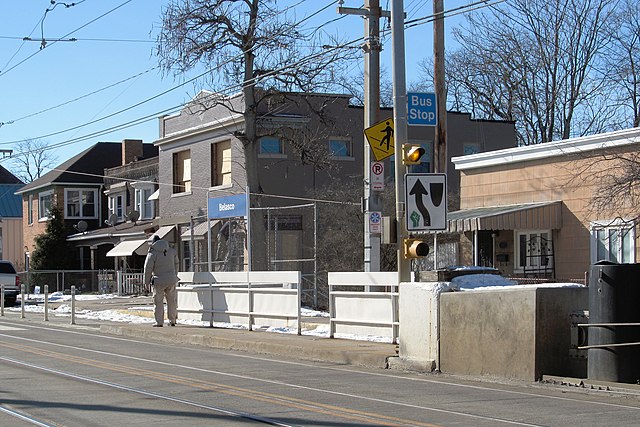
A snowy scene on a back street of Beechview. The hill in the distance is Brookline.

“Night Scene on the Monongahela River Near Pittsburgh, Pa., Showing a Portion of the Plants of the Pittsburgh Steel Co.” A striking view from a booklet published by the Pittsburgh Steel Company in 1911.

A passenger waits for a Red Line car on the Belasco safety island on Broadway, the main street of the Beechview neighborhood. His wait will not be long.

This 4200-series car rolled up seconds after the earlier picture was taken.
Pittsburgh used to be full of safety islands like these; wherever there was a broad street, the streetcars usually ran in the middle of it, avoiding the chaos of parking and double-parking along the edges. Broadway is the only street that has kept its safety islands, since elsewhere the streetcars mostly have their own right-of-way. (Warrington Avenue, used by the Brown Line when it is active, is narrow enough that passengers board from the curb.) There are three stops along the street trackage in Beechview; two others were eliminated a few years ago. Now Belasco is scheduled to be replaced with a platform-level station, which will be a boon to handicapped riders in Beechview. That will leave only the safety islands at Shiras and the single safety island at Hampshire (outbound passengers there board from the curb).


Above we can see the inbound safety island on the left. Behind the outbound stop, incidentally, is a typical Pittsburgh cliff house: a house whose street entrance is on the top floor, with the rest of the house clinging to a steep slope down from the street.


Because City Hall knows everything, as we can see from this 1892 view of one of the filing rooms in the old Pittsburgh City Hall. It came from a catalogue from the Office Specialty Mfg. Co, which supplied the filing cabinets.

The Washington Road business district as seen from Mount Lebanon Cemetery. Below, the Rollier’s clock tower, a relatively recent addition that anchors the north end of the business district perfectly.


A firehouse that looks very much like a firehouse, this was built in 1910, when the neighborhood was young, at a high point from which a fireman in the tower could see for miles.






A winter view of St. Bernard’s from Mt. Lebanon Cemetery, featuring a fine silhouette of a tree. Below, more church and less tree.


This was the place where the marvelous Ruud water heaters were produced. We take hot running water for granted today, but in this 1908 catalogue, the novelty is brought out in the “instructions” at the front of the book:
COMPLETE DIRECTIONS
Note carefully the instructions
for operating the Ruud
Water Heater
“TURN THE FAUCET”
You may add hot water in your home to the list of innovations for which Pittsburgh is responsible.